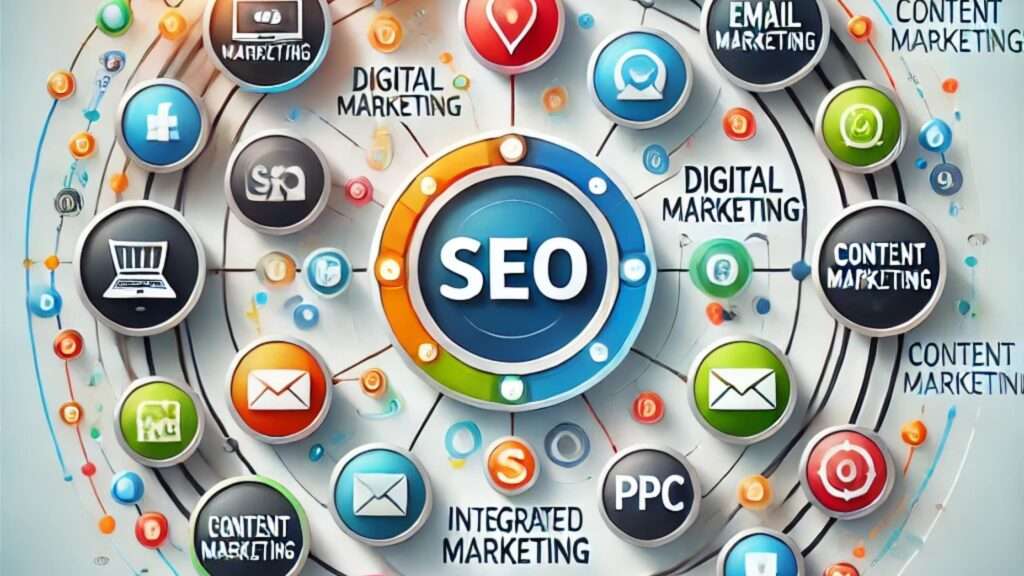
In today’s fast-paced digital landscape, businesses must adopt strategies that seamlessly combine various online marketing channels. Integrated digital marketing has emerged as the cornerstone of successful campaigns, allowing brands to deliver consistent messaging and maximize their reach. But what exactly does this term mean, and why is it essential for your business? Let’s explore.
What Is Integrated Digital Marketing?
Integrated digital marketing refers to the strategic use of multiple digital channels working together to create a unified and compelling brand experience. These channels often include:
- Search Engine Optimization (SEO): Enhancing your website’s visibility on search engines.
- Content Marketing: Creating valuable, relevant content to engage your audience.
- Social Media Marketing: Building relationships and promoting your brand on platforms like Instagram, Facebook, and LinkedIn.
- Email Marketing: Nurturing leads and keeping your audience informed.
- Pay-Per-Click Advertising (PPC): Driving traffic through targeted paid ads.
By integrating these channels, businesses can create synergy, amplifying the impact of their marketing efforts.
Why Integrated Digital Marketing Matters
- Consistent Messaging: Consumers interact with your brand across multiple platforms. Integrated marketing ensures your messaging remains cohesive, reinforcing brand identity.
- Improved ROI: By aligning campaigns across channels, businesses can optimize their resources, reducing redundancy and increasing efficiency.
- Better Customer Insights: Integrated efforts enable a holistic view of customer behavior, providing actionable data for more targeted campaigns.
- Enhanced Brand Authority: A consistent presence across platforms builds trust and establishes your brand as a leader in its niche.
Steps to Build an Integrated Digital Marketing Strategy
- Define Clear Objectives: Start with specific, measurable goals that align with your overall business strategy.
- Understand Your Audience: Use analytics and customer research to identify your target demographics.
- Create a Content Calendar: Plan and schedule content to ensure consistency and timely delivery.
- Utilize Marketing Automation Tools: Streamline your efforts and ensure smooth integration of campaigns.
- Measure and Optimize: Regularly track performance metrics and tweak your strategies for better outcomes.
Examples of Integrated Digital Marketing Success
Companies like Coca-Cola and Nike have mastered integrated digital marketing, blending creative campaigns across platforms to captivate audiences. Whether it’s a hashtag campaign on social media paired with engaging video content or a mix of influencer marketing and SEO-driven blog posts, these brands showcase the power of integration.
Final Thoughts
Integrated digital marketing isn’t just a buzzword; it’s a necessity in today’s competitive environment. By uniting your digital efforts, you can create a cohesive, impactful presence that resonates with your audience and drives measurable results.
Related Articles
- Amazon Digital Media Marketing: A Comprehensive Guide for Brands
- Unlocking Success with an Effective Website Marketing Campaign
- Amazon Digital Display Marketing: Unlocking the Power of Precision Advertising
- Crafting an Effective Digital Brand Strategy: The Blueprint for Success
- Direct Digital Marketing: A Guide to Building Personal Connections
- Difference Between Internet Marketing and Digital Marketing
- Difference Between E Marketing and Digital Marketing
- Difference Between Real Marketing and Digital Marketing
- Difference Between Performance Marketing and Digital Marketing
- Difference Between Online Marketing and Digital Marketing
- Difference Between Affiliate Marketing and Digital Marketing
- Understanding the Difference Between Marketing and Digital Marketing
- Difference Between Social Media Marketing and Digital Marketing
